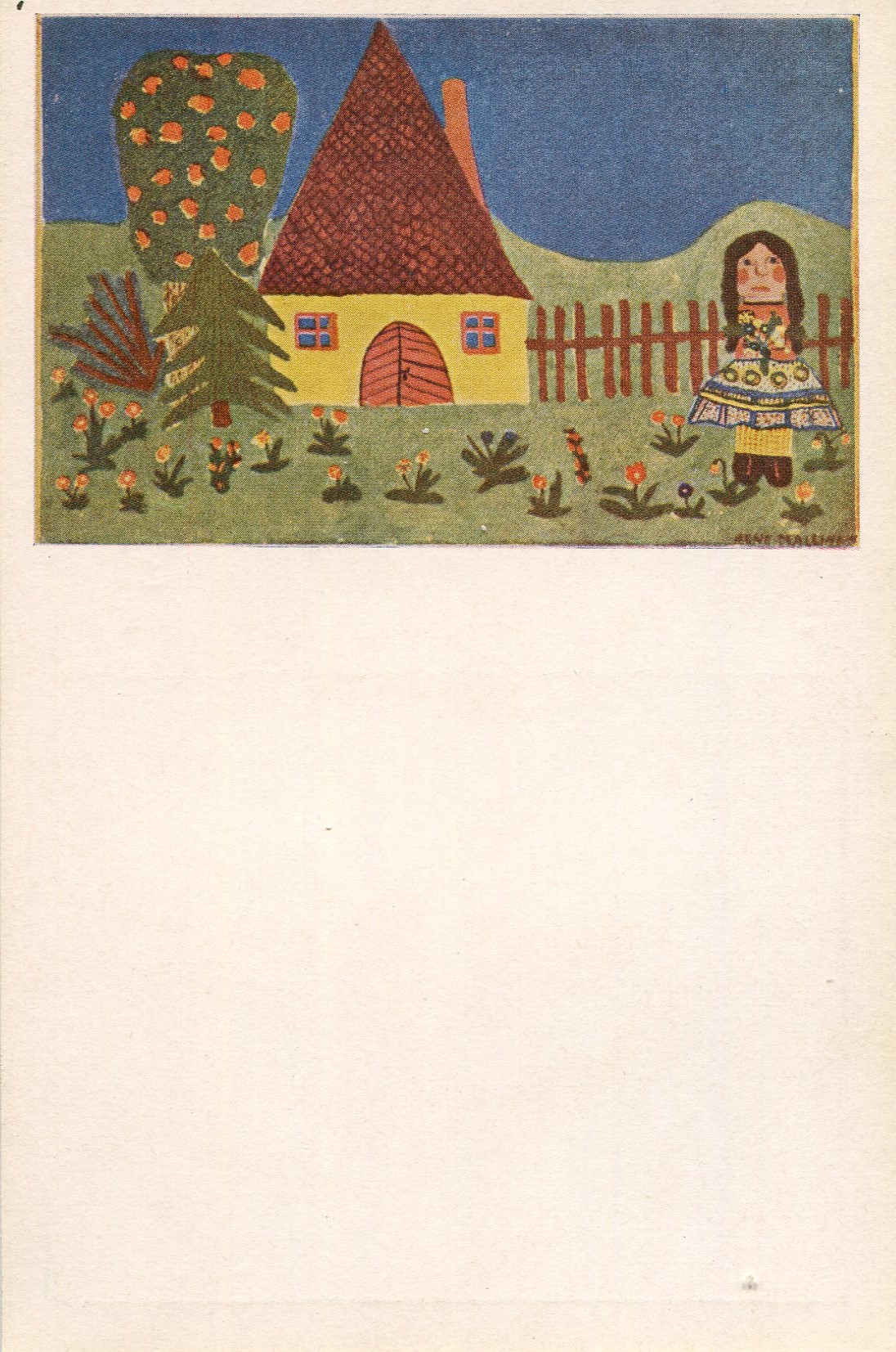Ray Hahn
Professor Cizek’s Juvenile Art Class
In all the world there has rarely been a more passionate advocate for children than the Austrian artist and teacher Franz Cizek. There is a familiar quote which comes from a speech he made before the Vienna schoolboard around 1895. He said, “What adults call ‘wrong’ in Child Art is the most beautiful and most precious. I value highly those things done by small children. They are the first and purest source of artistic creation.”

 Also …
Also …
 Card 6 is House and Child, a painting done by a girl of 8.
Card 6 is House and Child, a painting done by a girl of 8.

Card 8 is Animals, a painting done by a girl of 15

 Card 9 is Spring, a painting done by a girl of 14
Card 10 is Sunflowers, a painting done by a girl of 14
These cards and many like them are available on eBay.
* * *
Franz Cizek was born in Litomefice in northern Bohemia on June 12, 1865, near the end of the Austro-Prussian War. The area is now part of the Czech Republic. He left his home at age 19 to study in Vienna. When he turned 20 in 1885 he was accepted for admission to the Academy of Fine Arts. He studied enthusiastically with the German professors: Rumpler, von Trenkwald, and L’Allemand. The second two of these names should be familiar to German art-postcard collectors.
During his years at the Academy, Cizek lived with local families with children that he allowed to visit with him and use his art supplies. His temperament was quite suited to teaching and he openly encouraged them to express themselves. It was the beginning of his life-long devotion to art education. Early on Cizek organized and curated exhibitions of art by children and at age 32 he made his first attempt to establish open and free art education to the citizens of Vienna.
In 1904, after his appointment as director of the Department of Experimentation and Research, Cizek’s former students became teaching assistants in the children’s program, one of whom was Erika Klien – another name postcard collectors will recognize. Other former students moved to the United States and India and established similar programs in their new residences.
By 1920, children’s art programs were flourishing in England, Canada, Belgium, all the Scandinavian countries, and the United States. In November 1921 Francesca Wilson, a Birmingham teacher, exhibited the children’s art in London. That exhibition and others like it raised interest in the Child Art Movement to the extent that it was destined to become a worldwide program fully sanctioned and sponsored in many nations by the International Red Cross.
Franz Cizek never really retired but during the years of the second world war he took it upon himself to offer and fund art programs to protect children from the war and the tragic events it caused.
Cizek died in Vienna on December 17, 1946.
Card 9 is Spring, a painting done by a girl of 14
Card 10 is Sunflowers, a painting done by a girl of 14
These cards and many like them are available on eBay.
* * *
Franz Cizek was born in Litomefice in northern Bohemia on June 12, 1865, near the end of the Austro-Prussian War. The area is now part of the Czech Republic. He left his home at age 19 to study in Vienna. When he turned 20 in 1885 he was accepted for admission to the Academy of Fine Arts. He studied enthusiastically with the German professors: Rumpler, von Trenkwald, and L’Allemand. The second two of these names should be familiar to German art-postcard collectors.
During his years at the Academy, Cizek lived with local families with children that he allowed to visit with him and use his art supplies. His temperament was quite suited to teaching and he openly encouraged them to express themselves. It was the beginning of his life-long devotion to art education. Early on Cizek organized and curated exhibitions of art by children and at age 32 he made his first attempt to establish open and free art education to the citizens of Vienna.
In 1904, after his appointment as director of the Department of Experimentation and Research, Cizek’s former students became teaching assistants in the children’s program, one of whom was Erika Klien – another name postcard collectors will recognize. Other former students moved to the United States and India and established similar programs in their new residences.
By 1920, children’s art programs were flourishing in England, Canada, Belgium, all the Scandinavian countries, and the United States. In November 1921 Francesca Wilson, a Birmingham teacher, exhibited the children’s art in London. That exhibition and others like it raised interest in the Child Art Movement to the extent that it was destined to become a worldwide program fully sanctioned and sponsored in many nations by the International Red Cross.
Franz Cizek never really retired but during the years of the second world war he took it upon himself to offer and fund art programs to protect children from the war and the tragic events it caused.
Cizek died in Vienna on December 17, 1946.
I loved this story about the Children’s Art Movement. I previously knew nothing of it. Thanks for the article.
Francesca Wilson was my landlady in London, England in the mid 1970’s. She was a great supporter of the arts and an amazing woman.
My wife Cora and I lived in Francesca Wilson’s house from 1966 to 77. She was our friend, artistic supporter and we named our 3 Rd daughter after her. She had in her extensive library many books of children’s art. Eric Brittan
Of the works reproduced in this article, Girl with Goats is my favorite.
Very informative article. Thank you.
Beautiful art. Hadn’t heard of Cizek and this school….very interesting!